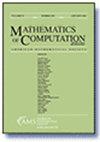Modified-operator method for the calculation of band diagrams of crystalline materials
IF 2.2
2区 数学
Q1 MATHEMATICS, APPLIED
引用次数: 0
Abstract
In solid state physics, electronic properties of crystalline materials are often inferred from the spectrum of periodic Schrödinger operators. As a consequence of Bloch’s theorem, the numerical computation of electronic quantities of interest involves computing derivatives or integrals over the Brillouin zone of so-called energy bands, which are piecewise smooth, Lipschitz continuous periodic functions obtained by solving a parametrized elliptic eigenvalue problem on a Hilbert space of periodic functions. Classical discretization strategies for resolving these eigenvalue problems produce approximate energy bands that are either non-periodic or discontinuous, both of which cause difficulty when computing numerical derivatives or employing numerical quadrature. In this article, we study an alternative discretization strategy based on an ad hoc operator modification approach. While specific instances of this approach have been proposed in the physics literature, we introduce here a systematic formulation of this operator modification approach. We derive a priori error estimates for the resulting energy bands and we show that these bands are periodic and can be made arbitrarily smooth (away from band crossings) by adjusting suitable parameters in the operator modification approach. Numerical experiments involving a toy model in 1D, graphene in 2D, and silicon in 3D validate our theoretical results and showcase the efficiency of the operator modification approach.晶体材料能带图计算的修正算子法
在固态物理中,晶体材料的电子特性通常是从周期性Schrödinger算符的谱中推断出来的。作为Bloch定理的结果,我们感兴趣的电子量的数值计算涉及计算所谓的能量带的布里因区域的导数或积分,这是通过在周期函数的Hilbert空间上求解参数化椭圆特征值问题而得到的分段光滑的Lipschitz连续周期函数。解决这些特征值问题的经典离散化策略产生非周期或不连续的近似能带,这两种情况在计算数值导数或采用数值正交时都会造成困难。在本文中,我们研究了一种基于特别算子修正方法的替代离散化策略。虽然在物理文献中已经提出了这种方法的具体实例,但我们在这里介绍了这种算子修正方法的系统表述。我们推导了所得能带的先验误差估计,并表明这些能带是周期性的,并且可以通过在算子修正方法中调整适当的参数来任意平滑(远离带交叉)。涉及一维玩具模型、二维石墨烯模型和三维硅模型的数值实验验证了我们的理论结果,并展示了算子修正方法的效率。
本文章由计算机程序翻译,如有差异,请以英文原文为准。
求助全文
约1分钟内获得全文
求助全文
来源期刊

Mathematics of Computation
数学-应用数学
CiteScore
3.90
自引率
5.00%
发文量
55
审稿时长
7.0 months
期刊介绍:
All articles submitted to this journal are peer-reviewed. The AMS has a single blind peer-review process in which the reviewers know who the authors of the manuscript are, but the authors do not have access to the information on who the peer reviewers are.
This journal is devoted to research articles of the highest quality in computational mathematics. Areas covered include numerical analysis, computational discrete mathematics, including number theory, algebra and combinatorics, and related fields such as stochastic numerical methods. Articles must be of significant computational interest and contain original and substantial mathematical analysis or development of computational methodology.
 求助内容:
求助内容: 应助结果提醒方式:
应助结果提醒方式:


